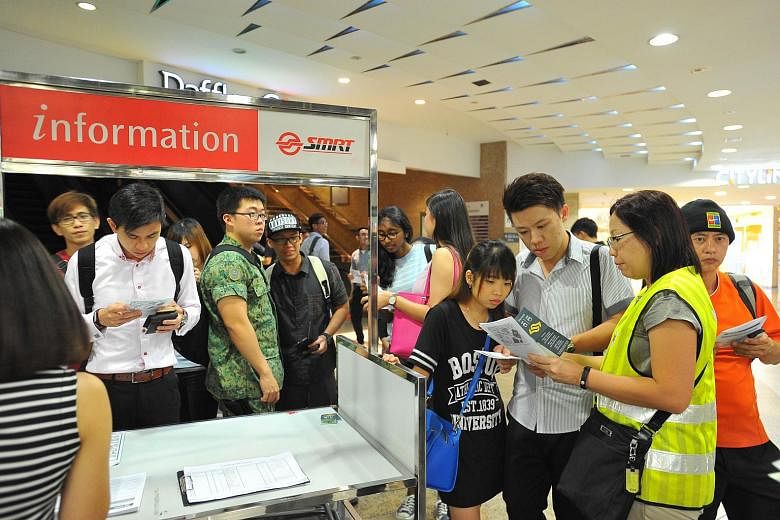Undergraduate Gillian Ng, 20, only realised there was a massive MRT disruption when she got to Braddell station on Tuesday evening.
She said there were no signs outside the station to inform commuters of a disruption, and it was only after she was denied entry that she realised that service had stopped.
Many commuters such as Ms Ng provided feedback on the limited information that was available on the disruption. Commuters, left stranded when the North-South and East-West MRT lines were closed, said they were unsure of where to go, who to speak to or what to do.
Experts said the lack of information given to commuters could have added to the severity of the situation. They noted that in such a situation, the key information that needs to be conveyed to commuters is: Should they wait in the station; how long the wait will be; and where they can board a bus if they have been advised to leave the station.
Mr Cedric Foo, chairman of the Government Parliamentary Committee (GPC) for Transport, said commuters would feel even more inconvenienced if they did not know what to do and naturally tempers would flare because of the uncertainty.
Mr Foo said commuters should be given the correct information "even if it means telling them it will take three hours for the system to get back up, because that means they can at least plan their route."
Service disruptions also need to be communicated to those who are on their way to the stations or are on unaffected lines, so they do not add to the congestion at closed stations.
This could be done through announcements at stations, interchanges and on buses, as well as through the mainstream media and social media, added experts.
Many of the initial announcements of service disruptions are now disseminated through social media such as Twitter and Facebook.
Many of the commuters caught in the congestion that evening also noted they were unable to speak to any station staff .
"These staff cannot be just inside the station, but also outside at bus stops or taxi stands," said retail manager Alicia Lee, 34 who was stuck at Jurong East station.
SMRT said it had deployed about 250 more staff across its 54 stations to help commuters.
Professor Lau Hoong Chuin of the Singapore Management University (SMU) said that with Singapore having one of the highest adoption of smartphones, the next step could be to develop a smart application which will give users more prompt updates on the situation.
It should also be able to detect the user's location and suggest alternative routes, taking into consideration the disrupted lines.
"Way finding is the next level; telling people where the bus that can take them out of the location is," said Prof Lau, who is director of SMU's Urban Computing and Engineering Corp Lab.
Transport consultant Tham Chen Munn said it would also be useful to identify the more popular routes and prepare signs with the directions. These could then be displayed as soon as a disruption happens.
But despite all the unhappiness, former UniSIM transport expert Park Byung Joon noted that before Tuesday, SMRT only had to deal with partial breakdowns of the system.
He said it is almost impossible to prepare for a breakdown of such a magnitude and that SMRT's response has improved from the first major breakdown in December 2011.
"It comes from experience, (breakdowns) have happened a few times before; the way resources are deployed is much quicker and staff in the station now know how to direct people," said Dr Park.

